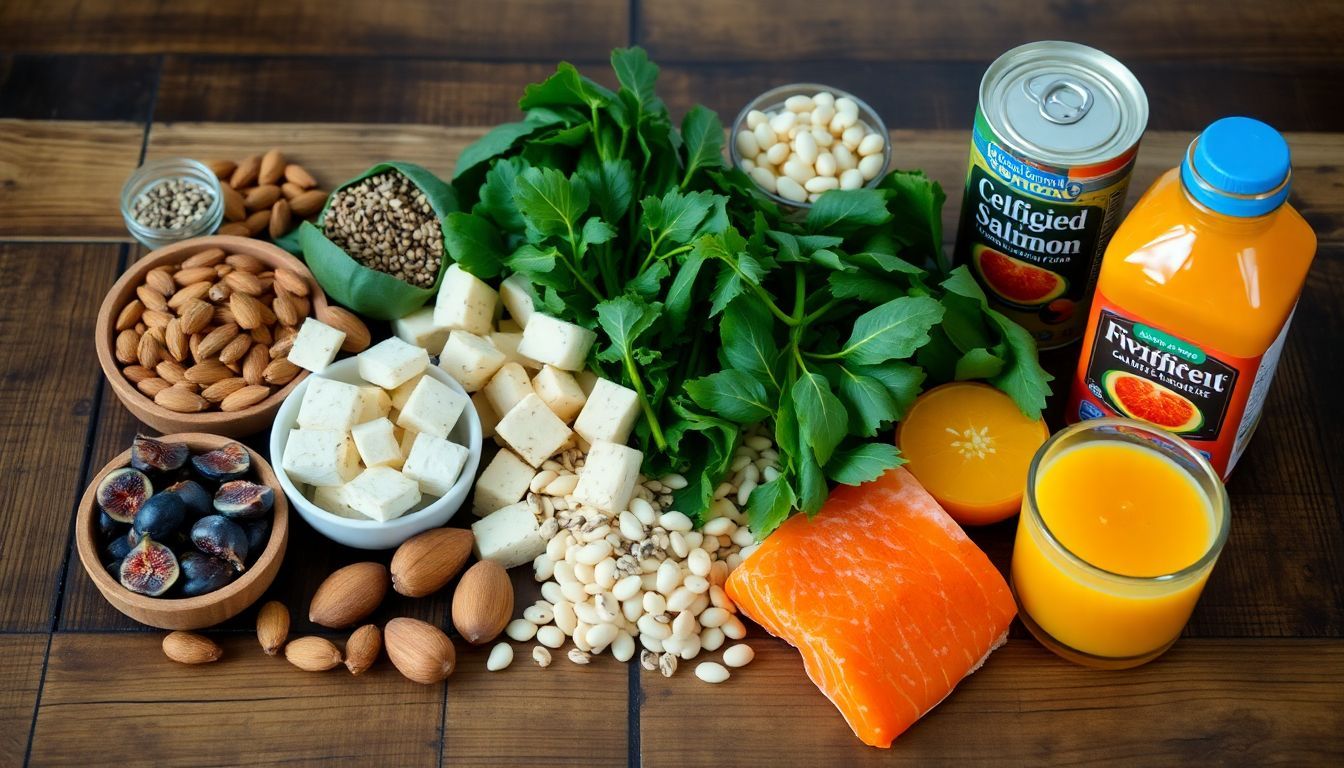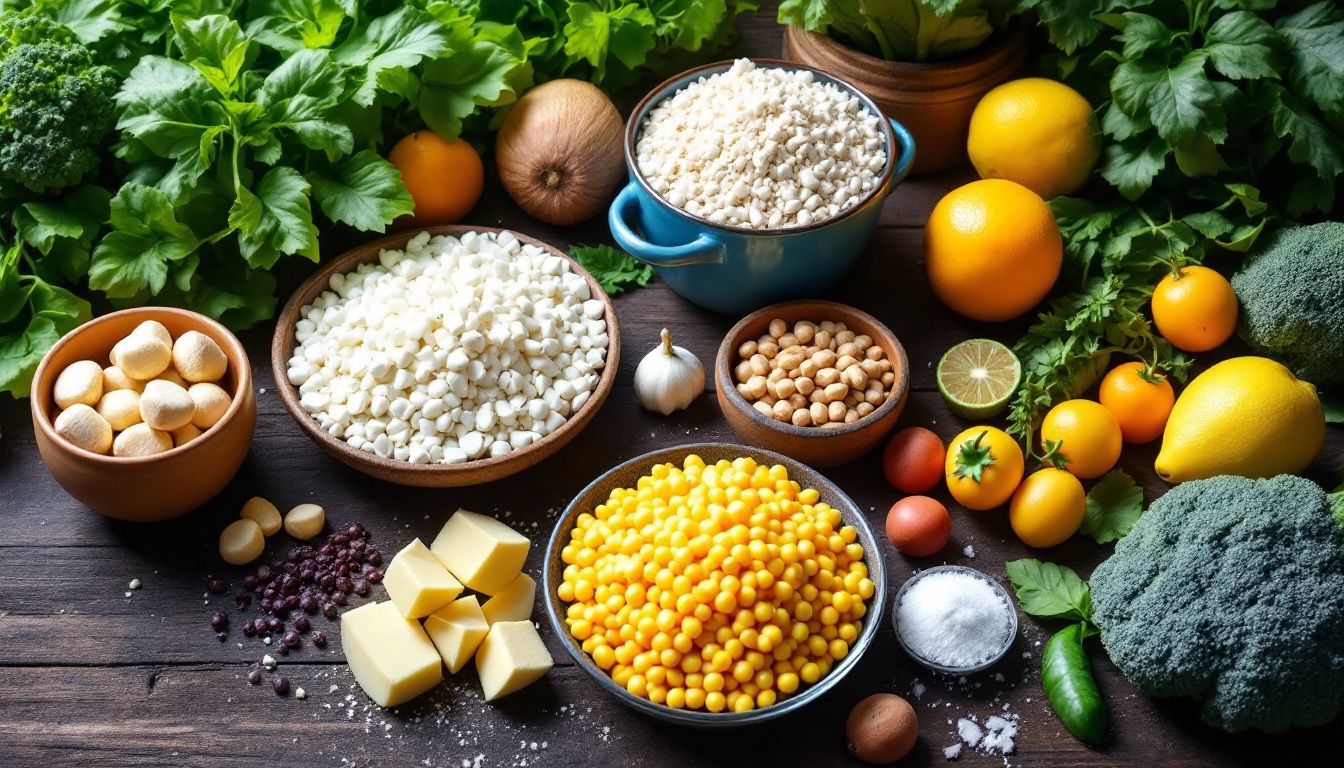Many people think dairy is the only way to get enough calcium for healthy bones. Did you know there are plenty of non-dairy foods packed with calcium too? This guide will show you simple, tasty options to strengthen your bones without cow’s milk.
Thank you for reading this post, don't forget to subscribe!Keep reading to find out more!
Key Takeaways
- Non-dairy foods like chia seeds, tofu, and collard greens are rich in calcium for strong bones. For example, half a cup of firm tofu can provide up to 861 mg of calcium.
- Fortified drinks such as soy milk and orange juice offer similar or higher calcium levels compared to cow’s milk. One glass of fortified orange juice delivers over 300 mg of calcium.
- Snacks like almonds (96 mg per quarter cup) and dried figs (241 mg per cup) are delicious ways to boost your daily calcium intake.
- Canned salmon with bones provides both calcium (232 mg per half-can) and heart-healthy omega-3 fats. Leafy greens add extra vitamins that aid bone health.
- Calcium-rich non-dairy foods cater to people with lactose intolerance or plant-based diets while supporting digestion and reducing disease risks.
Top Non-Dairy Sources of Calcium for Bone Health

Non-dairy foods can still give your body the calcium it needs for strong bones. Here are some excellent sources you can add to your diet:
- Chia Seeds – Just 2 tablespoons of chia seeds provide about 179 mg of calcium. They are also rich in omega-3 fatty acids and fiber.
- Fortified Soy Milk – One cup of fortified soy milk has as much calcium as cow’s milk. It’s a great option for people with lactose intolerance.
- Almonds – A quarter cup of almonds offers about 96 mg of calcium. While they’re nutritious, be mindful of portions due to their high calorie and fat content.
- Dried Figs – Eight dried figs (about one cup) pack around 241 mg of calcium, making them a sweet and healthy snack.
- Tofu – Firm tofu contains between 275 to 861 mg of calcium per half-cup, depending on its processing method.
- Leafy Greens – Vegetables like collard greens, turnip greens, bok choy, and mustard greens are rich in calcium and vitamins like K and C.
- White Beans – One cup provides roughly 161 mg of calcium along with protein and fiber for a balanced diet.
- Sesame Seeds – Just one tablespoon contains about 88 mg of calcium. Sprinkle them on salads or stir-fries for added crunch.
- Canned Salmon (with bones) – Half a can offers up to 232 mg of calcium while also providing heart-healthy omega-3 fats.
- Fortified Orange Juice – One glass can supply more than 300 mg of calcium depending on the brand you choose.
Now that you know these delicious options, let’s explore how they support overall health!
Benefits of Non-Dairy Calcium Sources
Non-dairy calcium sources support bone health without the cholesterol or saturated fat found in some dairy foods. Plant-based options like almonds, chia seeds, and collard greens are rich in vitamins and minerals.
Calcium-fortified orange juice offers about 300 mg per glass—great for boosting daily intake. Foods such as canned salmon and edamame beans provide additional benefits by including dietary protein crucial for strong bones.
Many non-dairy options promote better overall health. Leafy vegetables like bok choy offer fiber, which helps digestion. Fortified plant-based milks, such as soy milk and almond milk, often include added vitamin D for easier calcium absorption.
Calcium-rich dried figs serve as a tasty snack while reducing risks of type 2 diabetes. These foods cater to people with lactose intolerance or those who follow plant-based diets—all without sacrificing essential nutrients!
Tips for Incorporating Non-Dairy Calcium into Your Diet
Strong bones need regular calcium intake. You can boost bone health with non-dairy calcium-rich foods.
- Eat leafy greens like collard greens, turnip greens, and bok choy often. These are excellent food sources of calcium.
- Add fortified soy milk or almond milk to your beverages or cereals. They are great alternatives to dairy products and provide a healthy dose of calcium per serving.
- Snack on nuts and seeds like chia seeds, sesame seeds, and sunflower seeds for quick calcium boosts during the day.
- Enjoy a glass of calcium-fortified orange juice in the morning to start your day strong.
- Cook with white beans or canned salmon for meals rich in both protein and calcium.
- Use tofu or bean curd as a meat substitute in stir-fries or salads—it’s packed with plant-based calcium.
- Satisfy your sweet tooth with dried figs, which offer natural sugars along with essential minerals.
- Try amaranth grain in porridge or soups for a nutritious alternative rich in calcium and other nutrients.
- Replace plain yogurt with coconut milk-based yogurt if you prefer dairy-free snacks.
- Include mustard greens in your salads or side dishes—they’re low-calorie and nutrient-packed options for better bone health!
Conclusion
Taking care of your bones doesn’t have to involve dairy. Many non-dairy foods offer plenty of calcium and other nutrients. Options like almonds, tofu, chia seeds, and leafy greens can make a difference.
Add these foods to meals or snacks for better bone health. Eating well is a simple step toward stronger bones!
References
- https://www.urmc.rochester.edu/childrens-hospital/nutrition/calcium.aspx
- https://www.wholefoodsmarket.com/tips-and-ideas/archive/non-dairy-sources-calcium
- https://www.northshore.org/healthy-you/non-dairy-calcium-sources/ (2020-01-29)
- https://ods.od.nih.gov/factsheets/Calcium-HealthProfessional/ (2024-07-24)
- https://newsnetwork.mayoclinic.org/discussion/mayo-clinic-minute-how-to-get-calcium-without-dairy-products/ (2018-09-19)
- https://www.medicalnewstoday.com/articles/322585
